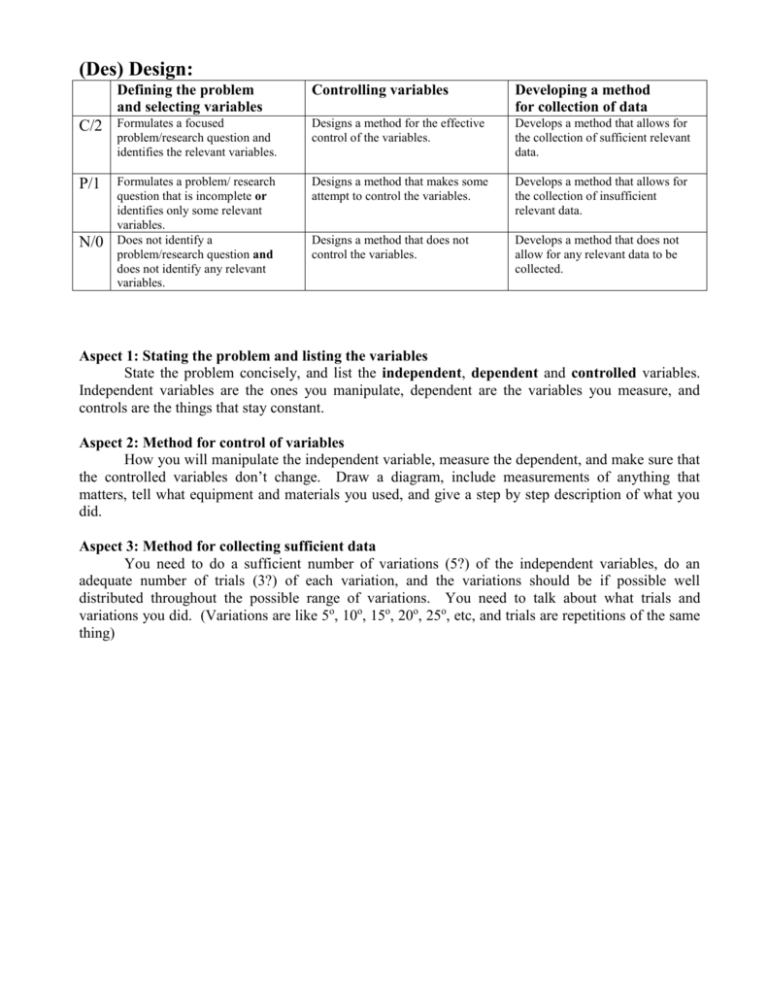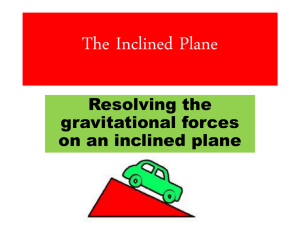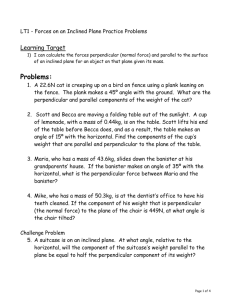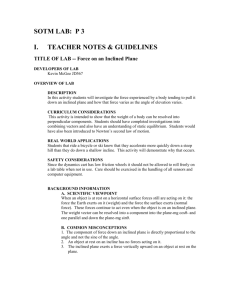IA-Des-Description
advertisement

(Des) Design: Defining the problem and selecting variables Controlling variables Developing a method for collection of data C/2 Formulates a focused problem/research question and identifies the relevant variables. Designs a method for the effective control of the variables. Develops a method that allows for the collection of sufficient relevant data. P/1 Formulates a problem/ research question that is incomplete or identifies only some relevant variables. Does not identify a problem/research question and does not identify any relevant variables. Designs a method that makes some attempt to control the variables. Develops a method that allows for the collection of insufficient relevant data. Designs a method that does not control the variables. Develops a method that does not allow for any relevant data to be collected. N/0 Aspect 1: Stating the problem and listing the variables State the problem concisely, and list the independent, dependent and controlled variables. Independent variables are the ones you manipulate, dependent are the variables you measure, and controls are the things that stay constant. Aspect 2: Method for control of variables How you will manipulate the independent variable, measure the dependent, and make sure that the controlled variables don’t change. Draw a diagram, include measurements of anything that matters, tell what equipment and materials you used, and give a step by step description of what you did. Aspect 3: Method for collecting sufficient data You need to do a sufficient number of variations (5?) of the independent variables, do an adequate number of trials (3?) of each variation, and the variations should be if possible well distributed throughout the possible range of variations. You need to talk about what trials and variations you did. (Variations are like 5o, 10o, 15o, 20o, 25o, etc, and trials are repetitions of the same thing) F Example: Suppose I am doing an experiment to see how the parallel force depends on the angle of an incline. Aspect 1: (After a bit of introductory information) The purpose of this investigation, then, is to determine the relationship between the force necessary to keep a wheeled cart from rolling down an incline, and the degree of that incline. The independent variable is the degree of incline, the angle it makes with the horizontal, the dependent variable is the force needed parallel to the plane to hold the cart stationary on the plane, and the controlled variables include, but are not limited to the mass of the cart, the position on the plane, the type of surface used, and the angle of the force scale used to measure the force. Aspect 2 Our setup consists of a 2.0 m long inclined plane that we propped up using a pile of books. We kept the mass of the cart constant at 1.85 kg, and always positioned the cart in the middle of the plane. The angle we measured using a protractor placed on the table surface, and we measured the force using a 20 N force scale for all trials. We took special care to keep the force scale parallel to the surface when we measured the force. To gather a data point, our procedure was this: First, we propped up the plane to the angle we desired, and measured this carefully keeping the protractor level with the table surface. Second, we tipped the force scale parallel to the plane, and made sure the scale read zero. If not, we adjusted the zero. Then we carefully attached the cart in the middle of the plane, and very slowly let it exert a force on the scale. We then read the force on the scale. Aspect 3 We chose to try the following angles: 10, 20, 30, 40, 50, 60, and 70. We could not get the plane to remain stationary for 80 degrees. For each variation, we did four trials of each angle to make sure that the measurements were repeatable.










